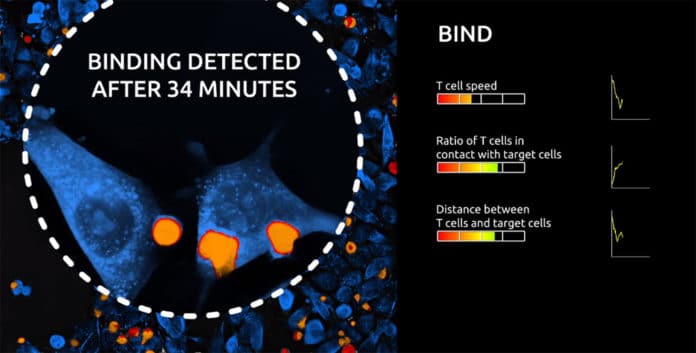Immuno-oncology, a promising new field of research, has been proven effective in treating certain types of cancer. Considering this, scientists are now testing an array of molecules to expand the range of potential applications.
These tests often require several instruments, which perform individual and specific analyses. However, the measurements taken by these instruments indirectly indicate how immune cells interact with cancer cells.
EPFL spin-off Nanolive has developed a new test called the Live T Cell Assay to measure the interaction directly. This Live T Cell Assay allows scientists to analyze the interaction between immune cells and cancer cells in real-time. It also let them observe T cell behavior in real-time and generate a quantitative analysis of numerous cell characteristics.
Thanks to this new test, scientists could directly see and quantify how T cells find, bind, stress, and kill cancer cells. This could prompt promising avenues of research for immuno-oncology treatments.
The test consists of a unique automated holotomographic microscope and algorithms developed to identify and extract data on T cells and the cancer cells they target. It employs imaging methods that leave the cells intact and allow scientists to observe them live over time.
The microscope generates 3D images of the distribution of refractive indices of the cell samples. It offers detailed data on the cells’ structures and chemical composition.
Scientists combined holotomography with AI and advanced computer vision techniques. They did so to distinguish T cells from cancer cells without markers and directly track the cells’ interactions.
Mathieu Frechin, the head of Artificial Intelligence for Quantitative Biology at Nanolive, said, “Our algorithms can sort through all these parameters and extract data on the different phases of the cells’ interaction, from the detection of binding and stress responses in cancer cells to the moment they are eventually killed. We’ve even seen that some T cells act as ruthless serial killers!”
Using the new approach, scientists could test several drug candidates simultaneously under optimal experimental conditions. They can also use it to extract automated analyses summarized in customizable charts and graphs.
Moreover, by allowing scientists to watch cell interactions live, the system also reveals phenomena that would be impossible to observe if the cells had to be immobilized.
Valery Moine, Head of Pharmacology Unit Light Chain Bioscience, said, “This is the first time we can see so nicely the killing process of T cells involved in vitro assays. We can also extract additional key parameters like the T cell killing rate and the average number of cancer cells killed by one T cell, which is very important because these types of parameters are not easily extracted using conventional methods.”
Other advantages of this Live T Cell Assay include:
- Enhanced downstream efficacy.
- Improved the success rates of clinical trials.
- Limits the need for in vivo testing
The information revealed by the system’s imaging technology goes beyond the automated analyses, as experienced users can comb through the data it generates and run their evaluations. Because Nanolive’s technique is non-invasive, the precious samples from patients can be reused for downstream applications such as cell therapy or personalized medicine.
